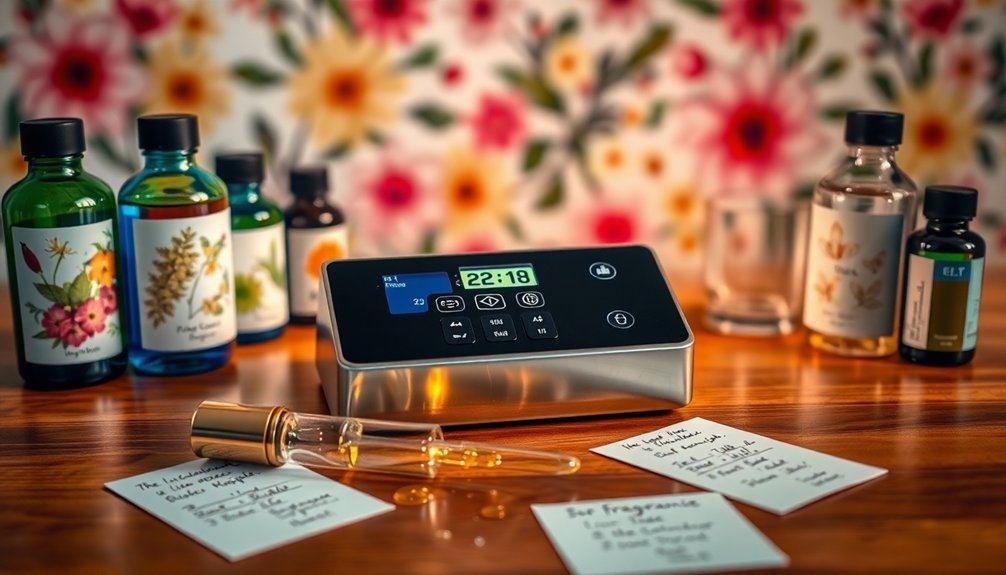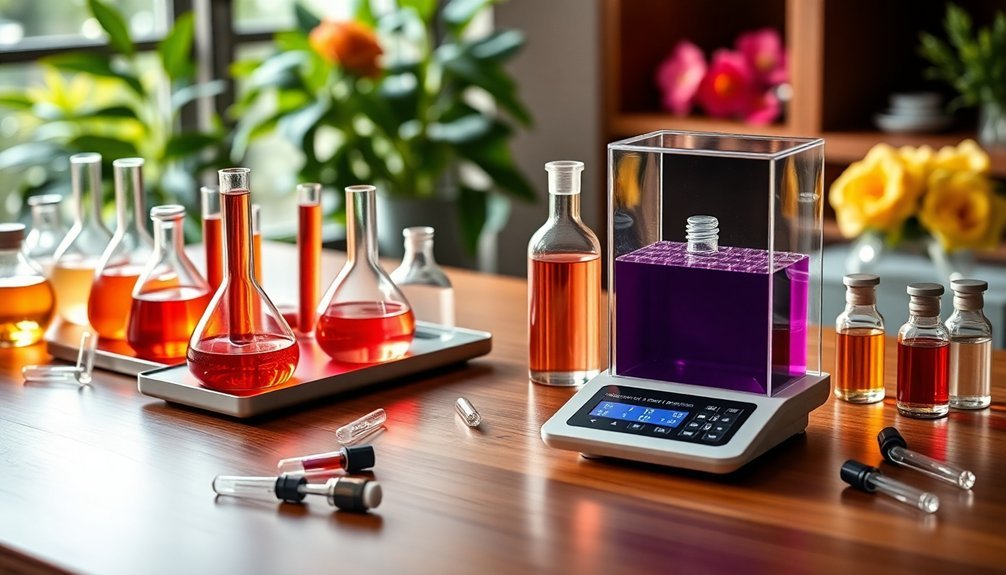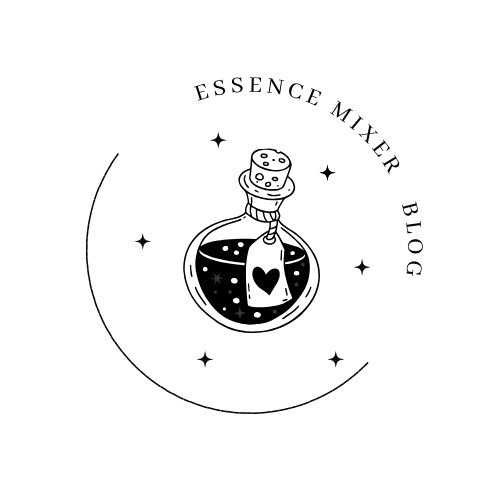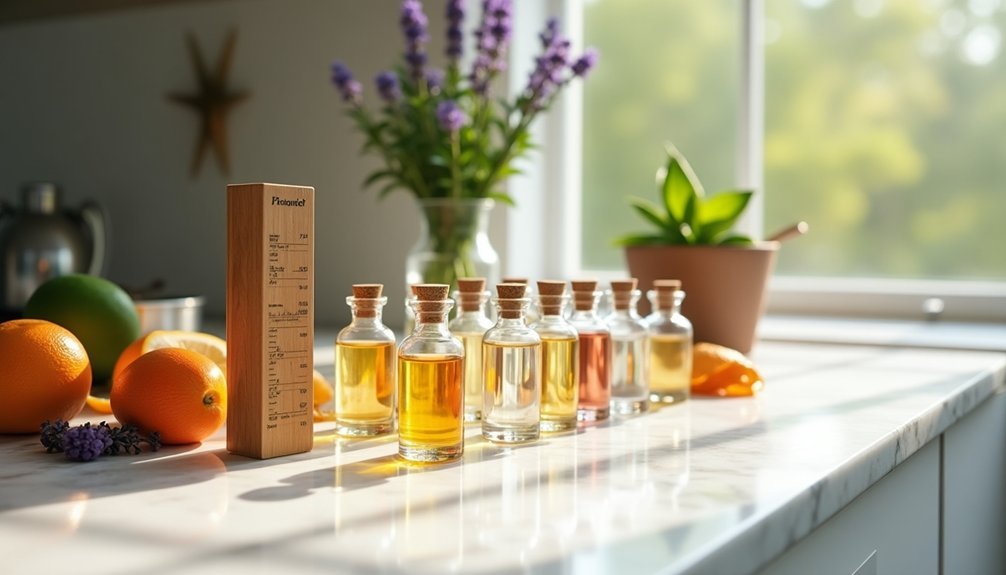Digital fragrance calculators make perfume blending precise and foolproof. You'll find user-friendly tools with dropdown menus for selecting wax types, scent strengths, and product categories. Basic calculators use the classic 30-50-20 rule, while advanced options handle complex dilutions and seasonal adjustments. Online calculators guarantee IFRA compliance and proper safety measures for your creations. Discover how these five essential tools can transform your fragrance-making journey.
Essential Tools for Digital Fragrance Calculations

While creating custom fragrances requires precise measurements, digital fragrance calculators have revolutionized the blending process.
You'll find user-friendly interfaces with simple input fields that make calculating fragrance percentages effortless. These tools let you select wax categories, scent strengths, and product types through intuitive dropdown menus. Subscribing to calculator services often provides 20% off first purchases.
Most digital calculators comply with IFRA guidelines, ensuring your blends meet safety standards and usage limits. You can adapt them for various products, from candles and soaps to lotions and cosmetics.
Whether you're working with soy wax, paraffin, or melt & pour bases, these calculators adjust for different materials. Plus, you'll find downloadable Excel spreadsheets that offer automated calculations and customizable formulas, making it easy to track your perfume concentrations and dilutions.
Basic Perfume Ratio Calculator Methods
Creating professional perfume blends starts with mastering basic ratio calculations that determine how your fragrances will interact.
You'll need to understand the classic 30-50-20 rule, where you'll allocate 30% for top notes, 50% for middle notes, and 20% for base notes.
To calculate your fragrance amounts, multiply your total weight by the fragrance load percentage divided by 100.
Then, break down this total amount using your chosen ratio. You can use alternatives like 3:3:1 or 1:1:1 for different effects.
For example, if you're using a 3:5:2 ratio, divide your total fragrance amount by 10 (sum of parts) to determine each part's value.
The most common fragrances for top notes include citrus and floral scents like bergamot and sweet orange.
Always use precise measuring tools and maintain detailed records of your calculations to guarantee consistency in future batches.
Advanced Dilution Calculator Techniques

Once you've mastered basic ratios, advanced dilution calculations let you work with complex concentrations and pre-diluted materials.
You'll need to calculate exact percentages by dividing the concentrate weight by the total mixture weight, ensuring precise measurements at every step.
When working with pre-diluted materials, you'll first identify the initial concentration, then calculate how much solution you need to achieve your target strength. Using a clean perfumer's alcohol solvent ensures optimal dilution results.
For example, if you're using a 20% jasmine solution and need 5% in your final blend, you'll need to determine both the amount of pre-diluted solution and additional solvent required.
For very potent materials, you can use serial dilution techniques.
This step-by-step process helps you achieve smaller concentrations accurately while conserving materials.
Always use a reliable scale and consider using spreadsheet tools to track your calculations.
Seasonal Blend Calculator Applications
Seasonal fragrance blending requires precise calculations that shift with changing weather and consumer preferences.
You'll need to adjust your fragrance concentrations using specialized calculators that factor in IFRA guidelines and product-specific requirements.
When you're creating seasonal blends, start by determining the desired scent intensity – light for spring/summer or stronger for fall/winter.
Use online calculators from suppliers like VINEVIDA or Bramble Berry to calculate safe usage rates for different product types.
For soap making, you'll want to account for the total batch weight and water content, while lotions and scrubs require different fragrance loads.
If you're working with multiple essential oils, track each oil's dilution rate and synergistic effects using software like Formulair to guarantee your seasonal blend remains both safe and effective.
Safety-First Fragrance Load Measurements

While perfume blending offers creative freedom, measuring fragrance loads demands strict adherence to safety protocols. You'll need to calculate your fragrance loads carefully, typically staying within 6-10% for ideal results. Always use glass containers instead of plastic, and add your oils when the wax reaches 185°F.
| Safety Measure | Why It Matters |
|---|---|
| Glass Containers | Prevents chemical reactions with plastic |
| Temperature Control | Maintains oil integrity at 185°F |
| Accurate Weighing | Guarantees proper oil-to-wax ratio |
| Proper Mixing | Ensures even scent distribution |
When measuring your fragrance loads, use this simple formula: multiply your total candle weight by your desired fragrance percentage (divided by 100). For example, a 16oz candle at 8% load needs 1.28oz of fragrance oil. Don't exceed your wax's maximum capacity, as this can compromise your candle's performance and safety.
Frequently Asked Questions
How Long Should Fragrance Blends Rest Before Evaluating Their Final Scent Profile?
You'll want to let your fragrance blend rest for at least 2-4 weeks before evaluating its final profile. For complex blends, you might need up to 6 months to achieve the best results.
Can Natural and Synthetic Fragrance Oils Be Combined in the Same Blend?
Yes, you can combine natural and synthetic fragrance oils in your blends. They'll work together to create more stable, complex scents. You'll get better longevity and can achieve unique fragrance profiles not possible with either alone.
What Causes Certain Fragrance Calculations to Produce Cloudy or Discolored Final Products?
You'll see cloudiness and discoloration when ingredients oxidize or react with each other. High concentrations of natural oils, exposure to light, and improper mixing ratios can trigger chemical reactions that alter your blend's appearance.
How Do Altitude and Humidity Affect Fragrance Calculator Measurements?
You'll need to adjust your measurements at higher altitudes due to lower air density and faster evaporation. In humid conditions, you'll require less fragrance oil since moisture helps scents project and last longer.
Why Do Some Fragrance Oils Separate Even After Precise Calculator Measurements?
Your fragrance oils can separate despite precise measurements due to natural ingredient variations, carrier oil compatibility issues, and environmental factors. Even when you measure perfectly, these elements still impact your blend's stability.
In Summary
You'll find these five digital fragrance calculators indispensable for your perfume-making journey. Whether you're a beginner learning basic ratios or an advanced blender tackling complex formulations, these tools will help you create safe, balanced scents year-round. Don't forget to bookmark these calculators and refer to them often – they're your key to consistent, professional-quality fragrance blending results every time.





Leave a Reply